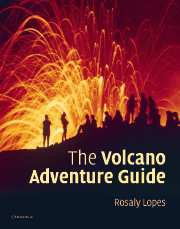Book contents
- Frontmatter
- Contents
- Preface
- Acknowledgments
- PART I Choosing a volcano to visit
- 1 Volcanoes of the World
- 2 The basic facts about volcanoes
- 3 Volcanic eruptions
- 4 Visiting volcanoes safely
- 5 Preparing and planning a volcano adventure
- PART II Guides to volcanoes
- Appendix I Useful information for preparing a volcano trip
- Appendix II Tours to volcanoes
- Bibliography
- Glossary
- Index
3 - Volcanic eruptions
from PART I - Choosing a volcano to visit
Published online by Cambridge University Press: 01 September 2010
- Frontmatter
- Contents
- Preface
- Acknowledgments
- PART I Choosing a volcano to visit
- 1 Volcanoes of the World
- 2 The basic facts about volcanoes
- 3 Volcanic eruptions
- 4 Visiting volcanoes safely
- 5 Preparing and planning a volcano adventure
- PART II Guides to volcanoes
- Appendix I Useful information for preparing a volcano trip
- Appendix II Tours to volcanoes
- Bibliography
- Glossary
- Index
Summary
The different types of volcanic eruptions
The term “volcanic eruption” can describe a wide variety of phenomena, from the gentle oozings of lava that sometimes go on for years to the catastrophic explosions that are quickly over but which impact the region for many years to come. Volcanologists tend to sort different volcanic eruptions by their “character”: this is a loose classification that reflects how explosive the eruptions are. It was pioneered by G. Mercalli, who is best known for his scale of seismic intensities. The classifications have been revised many times and volcanologists still disagree on how many types of eruptions there should be and on what these should be called. The only point that everyone seems to agree on is that classifying eruptions by their “character” is not very useful scientifically, but that it is quite handy for the purposes of expedient description. Terms such as “Hawaiian eruption” and “Plinian eruption” immediately bring to mind a picture of how explosive and dangerous the activity in question is. The differences are even clear from the simple diagram in Fig. 3.1.
Mercalli started the tradition of naming the different types of eruptions after volcanoes where they occur often. Hence we have, in order from least to most explosive: Hawaiian, Strombolian, Vulcanian, Peléean, Plinian, and Ultraplinian types.
- Type
- Chapter
- Information
- The Volcano Adventure Guide , pp. 28 - 40Publisher: Cambridge University PressPrint publication year: 2005

